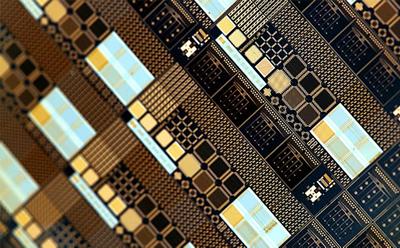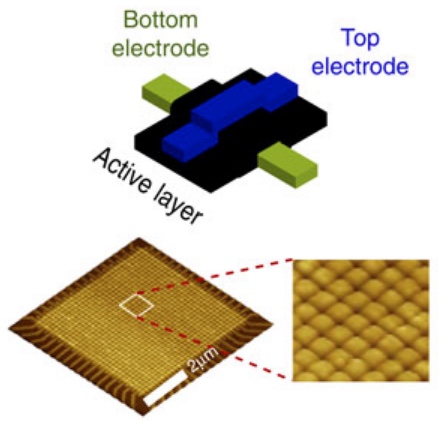Synapse-like memristor-based electronic device detects brain spikes in real time
September 30, 2016

Memristor chip (credit: University of Southampton)
A bio-inspired electronic device called a memristor could allow for real-time processing of neuronal signals (spiking events), new research led by the University of Southampton has demonstrated.
The research could lead to using multi-electrode array implants for detecting spikes in the brain’s electrical signals from more than 1,000 recording channels to help treat neurological conditions, without requiring expensive, high-bandwidth, bulky systems for processing data. The research could lead to future autonomous, fully implantable neuroprosthetic devices.

Schematic illustration of a solid-state titanium-oxide memristive device and atomic force microscopic (AFM) image a portion of a 32 × 32 crossbar array of memristors (credit: Isha Gupta/Nature Communications)
A memristors is an electronic component that limits or regulates the flow of electrical current in a circuit, can remember the amount of charge that was flowing through it, and retain that data, even when the power is turned off. The researchers used an array of memristors.
The research team designed a new nanoscale device they called a “memristive integrating sensor” (MIS) based on a memristors and associated electronic circuits for detecting spikes.*
Acting like synapses in the brain, the MIS was able to encode and compress (up to 200 times) neuronal spiking activity recorded by multi-electrode arrays. Besides addressing the bandwidth constraints, this approach was also very power-efficient; the power needed per recording channel was up to 100 times less when compared to current best practice.
The research was published in the open-access journal Nature Communications.
The Prodromakis Group at the University of Southampton collaborated among others with Leon Chua (a Diamond Jubilee Visiting Academic at the University of Southampton), who theoretically predicted the existence of memristors in 1971.
This interdisciplinary work was supported by an FP7 project (the European Union’s Research and Innovation funding) and brought together engineers from the Nanoelectronics and Nanotechnology Group at the University of Southampton with biologists from the University of Padova and the Max Planck Institute, Germany, using the state-of-art facilities of the Southampton Nanofabrication Centre.
* The paper explains that signals from an array of neural electrodes are fed into the MIS system as a series of voltage-time samples. “The MIS begins by pre-amplifying the incoming signal to voltage levels suitable for operating the memristor sitting at the core of the MIS and then proceeding to apply the pre-amplified signals to the memristor in real-time. The memristor’s resistive state is assessed periodically and when a significant change in comparison to the previous state is detected, the system registers a spiking event.”
Abstract of Real-time encoding and compression of neuronal spikes by metal-oxide memristors
Advanced brain-chip interfaces with numerous recording sites bear great potential for investigation of neuroprosthetic applications. The bottleneck towards achieving an efficient bio-electronic link is the real-time processing of neuronal signals, which imposes excessive requirements on bandwidth, energy and computation capacity. Here we present a unique concept where the intrinsic properties of memristive devices are exploited to compress information on neural spikes in real-time. We demonstrate that the inherent voltage thresholds of metal-oxide memristors can be used for discriminating recorded spiking events from background activity and without resorting to computationally heavy off-line processing. We prove that information on spike amplitude and frequency can be transduced and stored in single devices as non-volatile resistive state transitions. Finally, we show that a memristive device array allows for efficient data compression of signals recorded by a multi-electrode array, demonstrating the technology’s potential for building scalable, yet energy-efficient on-node processors for brain-chip interfaces.